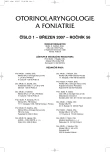Microbial Population of Healthy External Auditory Canal
Authors:
K. Pokorný 1; L. Poustecká 2
Authors‘ workplace:
Klinika ORL a chirurgie hlavy a krku Krajské nemocnice Pardubice
; přednosta prof. MUDr. A. Pellant, DrSc.
Mikrobiologické oddělení Krajské nemocnice Pardubice
1; prim. MUDr. L. Poustecká
2
Published in:
Otorinolaryngol Foniatr, 56, 2007, No. 1, pp. 7-10.
Category:
Original Article
Overview
Anatomy of the external auditory canal tends toward relative stable environment. Nutritions present in cerumen make this relative warm and humid milieu with lack of light appropriate for growth of microorganisms. But the external otitis develops less frequently than could be expected.
Bacterial samples were collected from the cerumen and adequate portion of external auditory canal of 50 persons with normal otoscopic findings. Total bacterial rods isolated were 65 from the external ear canal and 64 from the cerumen. Only in 5 subjects were both samples (ear wax and external ear canal) negative. The predominant bacterial rods were Staphylococcus epidermidis and Staphylococcus aureus. There were also isolated bacteria taken usually for pathogens, as Pseudomonas aeruginosa, Klebsiella pneumoniae a Candida albicans. The paper brings a review of knowledge of factors influencing microbial colonisation of external auditory canal.
The outcome of our and other identical published studies are pointing out the fact that it is necessary to change the perspective of microbiological flora of external ear canal and to relate it to current local finding. Microbes commonly occurring in healthy ears could change in other conditions to pathogens and contribute to ear inflammation, or they could help to preserve the chronic inflammation.
Key words:
healthy external auditory canal, microbial flora, cultivation results.
Sources
1. Bjorab, D. I., Bruderly, T., Abdulrazzak, Y.: Otitis externa. Otolaryngologic clinics of North America, 29, 1996, č. 5, s. 761-781.
2. Brook, I., Coolbaugh, J. C., Williscroft, R. G.: Effect of diving and diving hoods on the bacterial flora of the external ear canal and skin. J. Clin. Mikrobiol., 15, 1982, č. 5, s. 855-859.
3. Brook, I., Coolbaugh, J. C., Bethesda: Changes in the bacterial flora of the external ear canal from the wearing of the occlusive equipment. Laryngoscope, 94, 1984, s. 963-965.
4. Brook, I., Frazier, E. H., Thompson, D. H.: Aerobic and anaerobic microbiology of external otitis. Clin Infect Dis, 15, 1992, s. 995-998.
5. Campos, A., Arias, A., Bentacor, L., Rodríguez, C., Hernández, A. M., Aguado, D. L., Sierra, A.: Study of common aerobic flora of human cerumen. J Laryngol Otol, 112, 1998, s. 613-616.
6. Campos, A., Bentacor, L., Arias, A., Rodríguez, C., Hernández, A. M., Aguado, D. L., Sierra, A.: Influence of human wet cerumen on the growth of common and pathogenic bacteria of the ear. J Laryngol Otol, 114, 2000, s. 925-929.
7. Chai, T., Chai, T.C.: Bactericidal activity of cerumen. Antimicrob Agents Chemother, 18, 1980, s. 638–641.
8. Jankowski, A., Kapusta, E., Nowacka, B.: Concerning the bacteriostatic or bactericidal function of the secretion of ceruminous glands. Otolaryngol Poland, 46, 1992, s. 557-560.
9. Megarry, S., Pett, A., Scarlett, A., Teh, W., Zeigler, E., Canter, R. J.: The activity against yeasts of human cerumen. J Laryngol Otol, 102, 1988, s. 671–672.
10. Pata, Z. S., Öztürk, C., Zkvas, Y., Ünal, M., Görür, K., Özcan, C.: Microbiology of cerumen in patients with recurrent otitis externa and cases with open mastoidectomy cavities. J Laryngol Otol, 118, 2004, s. 260-262.
11. Petrakis, N. L., Roberty, M., Lee, R. E., Smith, S. C., Page, N. L.: Demonstration and implications of lysozyme and immunoglobulins in human ear wax. Nature, 229, 1971, s. 119-120.
12. Pieren, C.: Otitis externa und cerumen obturans. Terapeutische Umschau, 52, 1995, č. 11, s. 713-717.
13. Pokorný, K., Pellant, A.: Fyziologické vlastnosti ušního mazu. Otorinolaryng. a Foniat. /Prague/, 52, 2003, č. 4, s. 167-169.
14. Roeser, J. R., Ballachanda, B. B.: Physiology, pathophysiology, and antropology/epidemiology of human earcanal secretions. J Am Acad Audiol, 8, 1997, s. 391-400.
15. Roth, R. R, James, W. D.: Mikrobiology of the skin: Resident flora, ecology, infection. J Am Acad Dermatos, 20, 1989, s. 367-390.
16. Sirigu, P., Perra, M. T., Ferreli, C., Maxia, C., Turno, F.: Local immune response in the skin of the external auditory meatus: An immunohistochemical study. Microsc. Res. Tech., 38, 1997, s. 329-334.
17. Sokolov, V. E., Ushakova, N. A., Chernova, O.F., Shubkina, A. V.: On antiinfectional properties of cerumen in mammals, Izv Akad Nauk Ser Biol, 1995, č. 5, s. 579-585.
18. Stenfors, L. E., Räisänen, S.: Quantity of aerobic bacteria in the bony portion of the external auditory canal of children. Int. J. Pediatr. Otorhinolaryngol., 66, 2002, s. 167-173.
19. Stone, M., Fulghum, R. S.: Bactericidal activity of wet cerumen. Ann Otol Rhinol Laryngol, 93, 1984, s. 183–186.
20. Stroman, D. W., Roland, P. S., Dohar, J., Burt, W.: Microbiology of normal external auditory canal. Laryngoscope, 111, 2001, 11, s. 2054-2059.
21. William, B. C., Brook, I., Bianki, D., Thompson, D. H.: Microbiology of otitis externa. Otolaryngol Head Neck Surg,, 116, 1997, s. 23-25
22. Wright, D. N., Alexander, J. M.: Effect of water on the bactrerial flora of swimmers‘ ears. Arch Otolaryngol, 99, 1974, s. 15-18.
Labels
Audiology Paediatric ENT ENT (Otorhinolaryngology)Article was published in
Otorhinolaryngology and Phoniatrics

2007 Issue 1
Most read in this issue
- Quality of Life in Patients with Tracheostomy
- Results of Therapy in Early Stages of Glottic Larynx Cancer Summary
- Chylous Fistulas
- Complex Re-education of Voice in AFC
